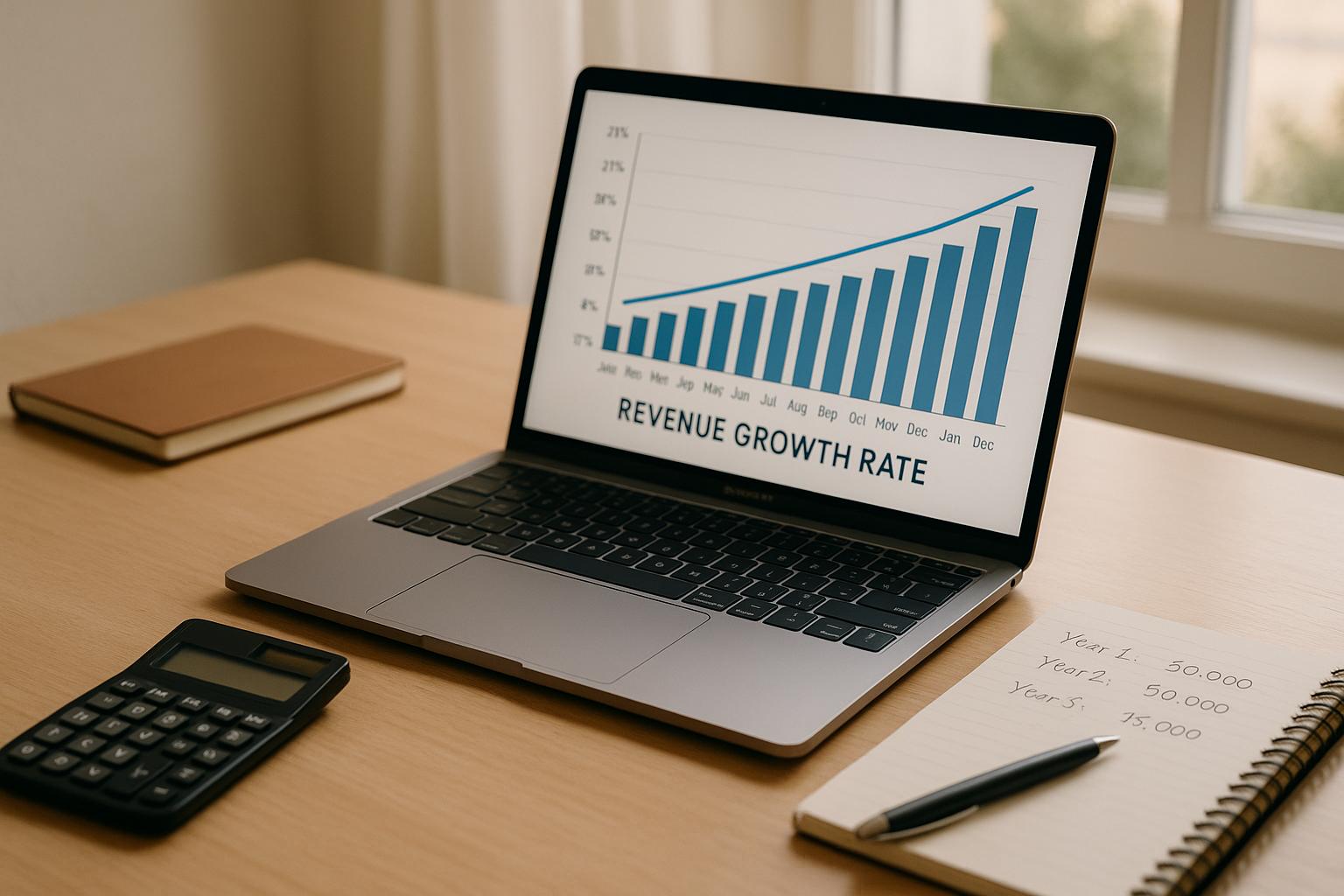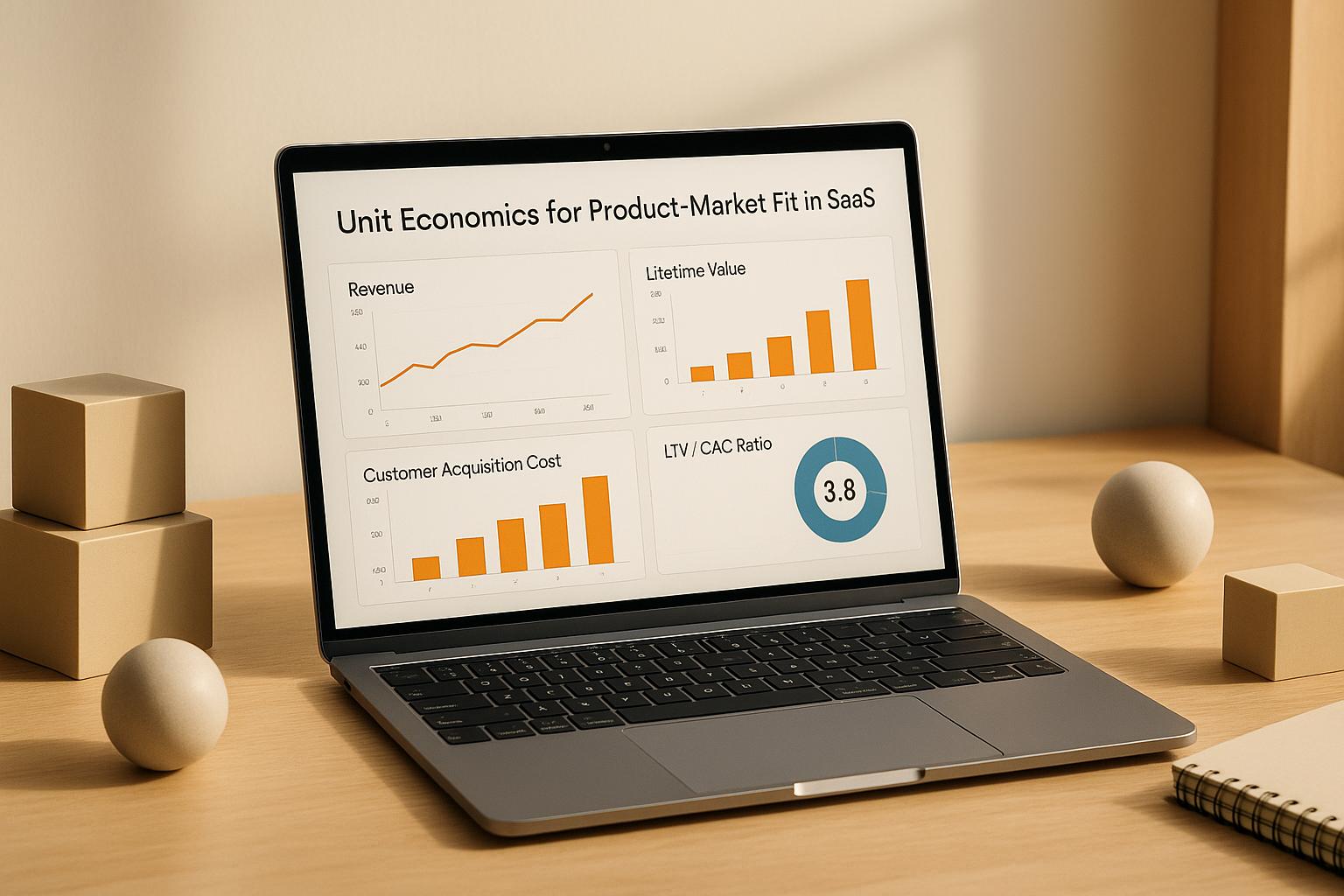5 Steps to Build Rolling Forecast Models

Rolling forecasts are a dynamic way to plan for the future by continuously updating projections based on the latest data. Unlike static annual budgets, rolling forecasts shift forward regularly, keeping a consistent time horizon (e.g., 12-18 months). They help businesses stay flexible, improve accuracy, and allocate resources more effectively.
Key Takeaways:
- What They Are: Rolling forecasts update monthly or quarterly to maintain a forward-looking window.
- Why They Matter: They improve cash flow management, adapt to market changes, and reduce the workload of annual budgeting.
- Who Benefits: Especially useful for mid-sized companies to monitor cash flow, spot funding needs, and plan for growth.
The 5 Steps:
- Set Your Framework: Define the forecast period (e.g., 12 months), update schedule (weekly/monthly), and key metrics to track.
- Review Past Data: Analyze historical trends, seasonal patterns, and growth rates to inform your predictions.
- Create Assumptions: Identify revenue drivers, cost dependencies, and market factors to build realistic projections.
- Design the Model: Use tools like Excel or FP&A software, structure inputs/outputs, and calculate revenue, costs, and cash flow.
- Run & Update: Regularly update forecasts (weekly/monthly/quarterly) and refine assumptions based on actual results.
Quick Comparison: Forecasting Tools
| Tool Type | Best For | Features |
|---|---|---|
| Excel/Google Sheets | Small teams | Custom formulas, dashboards, sharing |
| FP&A Software | Large setups | Advanced modeling, real-time updates |
| Cloud-Based Solutions | Remote collaboration | Team collaboration, mobile access |
Rolling forecasts are a practical solution for businesses looking to stay ahead in a fast-changing market. Start by setting up a clear framework, analyzing past data, and using the right tools to keep your forecasts accurate and actionable.
Step 1: Set Your Forecast Framework
To make rolling forecasts work for your business, start by creating a framework that matches your goals. This framework will guide how your forecast operates and the insights it delivers. Define the forecast period, how often you'll update it, and the key metrics you'll track.
Choose Your Time Period
Pick a time frame that suits your business cycle. A 12-month window is often a good balance between clarity and precision. However, you might need to tweak it based on your business type:
- Seasonal businesses: Go for an 18-month window to account for seasonal fluctuations.
- Project-based companies: Match the forecast to project timelines.
- Growth-focused companies: Consider 12–24 months to align with funding cycles.
Set Update Schedule
Regular updates are crucial. According to Phoenix Strategy Group, weekly reviews and monthly full updates can help you stay on top of market changes, spot trends, keep teams aligned, and make informed decisions.
Here’s a simple schedule to follow:
- Weekly: Review key metrics.
- Monthly: Update the entire forecast.
Select Key Metrics
Choose metrics that reflect your business goals and performance. These metrics generally fall into a few main categories:
| Category | Metrics to Track | How Often to Update |
|---|---|---|
| Revenue | Monthly recurring revenue, Customer acquisition cost, Lifetime value | Weekly |
| Operations | Gross margin, Operating expenses, Burn rate | Weekly |
| Cash Flow | Working capital, Cash conversion cycle, Days sales outstanding | Monthly |
| Growth | Customer churn, Revenue growth rate, Market penetration | Monthly |
When deciding on metrics, think about:
- Actionability: Focus on metrics your team can directly influence.
- Accessibility: Make sure the data is easy to get.
- Accuracy: Use reliable data sources.
- Alignment: Tie metrics to your strategic goals.
This approach ensures your forecast stays relevant and actionable.
Step 2: Review Past Performance
Dive into past data to make well-informed predictions. This step sets the stage for creating actionable forecasts.
Gather Financial Data
Start by collecting detailed financial and operational data from your key systems. Focus on these categories:
| Data Category | Key Metrics | Collection Frequency |
|---|---|---|
| Financial Statements | Income statements, Balance sheets, Cash flow statements | Monthly |
| Sales Performance | Revenue by product/service, Sales pipeline, Win rates | Weekly |
| Operating Costs | Fixed costs, Variable expenses, Labor costs | Monthly |
| Customer Metrics | Acquisition costs, Lifetime value, Churn rates | Weekly |
Identify Data Patterns
Look for trends in your historical data that can guide your forecasting decisions:
Seasonal Variations
- Revenue shifts during specific months or quarters
- Changes in operating costs tied to business cycles
- Customer behavior trends across the year
Growth Trends
- Month-to-month revenue growth
- Customer acquisition patterns
- How costs scale as you grow
Business Correlations
- The link between marketing spend and revenue
- Effects of pricing adjustments on sales
- How headcount changes impact productivity
Spotting these patterns will help you make more realistic predictions.
Verify Data Accuracy
The quality of your data directly impacts the reliability of your forecasts. Use these steps to ensure accuracy:
-
Standardize and Verify Metrics
- Use consistent metrics across all departments
- Perform regular audits to catch and fix discrepancies
-
Document Data Sources
- Keep track of where your data comes from and how it’s calculated
- Stick to uniform reporting methods
Before diving into modeling, clean and organize your data:
- Remove duplicates and fix errors
- Standardize formats for consistency
- Fill in missing data points
- Double-check anything that looks unusual
Accurate, clean data is the foundation of reliable forecasting.
Step 3: Create Business Assumptions
Turn past performance into actionable assumptions that connect your business activities to financial outcomes. This step links your historical analysis to your future strategy.
Identify Key Revenue Drivers
When building your forecast, zero in on the main factors that drive revenue growth. These metrics are essential for understanding how to achieve top-line growth:
| Category | Key Metrics | Impact on Forecast |
|---|---|---|
| Revenue Drivers | – Sales Volume – Customer Growth |
Direct influence on revenue growth |
Create Financial Connections
Tie operational changes to your financial projections. Focus on these areas:
- Revenue Relationships: For example, increasing marketing spend can lead to more leads, a stronger sales pipeline, faster revenue growth, and lower customer acquisition costs.
- Cost Dependencies: Understand how scaling your business affects costs, such as hiring new employees, investing in technology, or expanding support teams.
- Operational Impacts: Factor in shifts in production capacity, resource usage, quality measures, and team efficiency.
Factor in Market Conditions
Incorporate external influences to refine your assumptions and make them more accurate:
- Economic Indicators: Pay attention to trends like interest rates, industry growth patterns, market demand shifts, and competitive dynamics.
- Seasonal Patterns: Account for revenue changes during different quarters, peak resource demands, cash flow timing, and customer purchasing habits.
- Industry-Specific Factors: Consider regulatory updates, technology adoption rates, supply chain challenges, and evolving customer behavior.
"As our fractional CFO, they accomplished more in six months than our last two full-time CFOs combined. If you're looking for unparalleled financial strategy and integration, hiring PSG is one of the best decisions you can make." - David Darmstandler, Co-CEO, DataPath
sbb-itb-e766981
Step 4: Design Your Forecast Model
Turn your assumptions into a working forecast model that helps guide your business decisions.
Choose Your Software
Start by selecting the right software to build your model. Look for tools that can handle complex calculations and are easy to update regularly. Here’s a quick comparison:
| Software Type | Best For | Key Features |
|---|---|---|
| Excel/Google Sheets | Small to mid-sized teams | - Custom formulas - Visual dashboards - Easy sharing |
| Enterprise FP&A Tools | Larger, complex setups | - Advanced modeling - Real-time updates - Automated data feeds |
| Cloud-Based Solutions | Remote collaboration | - Team collaboration - Version control - Mobile access |
Organize Your Model Layout
Once you’ve picked your tool, structure your model for clarity and efficiency. A clean layout ensures smooth data flow and easier updates. Include these components:
- Input Sheets: Use separate tabs for historical data, assumptions, and external market variables.
- Calculation Engine: A central worksheet to process your core financial metrics.
- Output Dashboards: Visualize key forecasts and variances for quick insights.
Pro tip: Use color coding to make your model easier to navigate - blue for inputs, white for calculations, yellow for key outputs, and gray for references.
Build Your Calculations
Now it’s time to add the calculations that will power your forecasts.
-
Revenue Projections
Connect sales drivers to revenue by incorporating growth rates, seasonal trends, price adjustments, and retention rates. -
Cost Analysis
Break down expenses by linking operational metrics to costs. Consider:- Fixed vs. variable cost ratios
- Headcount planning
- Resource utilization
- Overhead allocation
-
Cash Flow Projections
Build a dynamic cash flow model with:- Collection periods
- Payment terms
- Working capital needs
- Timing for capital expenditures
These calculations will form the foundation of your forecasting process, keeping it accurate and adaptable as your business evolves.
Step 5: Run and Update Your Forecast
Once your model is ready, it's important to keep it up-to-date so it remains effective for decision-making.
Set an Update Schedule
Stick to a clear schedule for updating your forecast to keep it accurate and useful:
| Update Type | Frequency | Key Focus Areas |
|---|---|---|
| Weekly Review | Every Monday | Compare actuals to forecasts, track KPIs, make quick adjustments |
| Monthly Deep Dive | First week | Analyze variances, update assumptions, refine targets |
| Quarterly Reset | End of each quarter | Revise major assumptions, adjust for market changes, align strategies |
Having this structure ensures your team stays on the same page and can act quickly when needed.
Prepare Your Team
Your team plays a critical role in maintaining the quality of your forecast. Here’s how to set them up for success:
1. Assign Clear Responsibilities
Make sure each department knows which KPIs and targets they’re responsible for. Weekly check-ins can help clarify how their metrics tie into the overall forecast.
2. Standardize Data Collection
Set up a consistent process for gathering data. This includes regular reporting schedules, quality checks, and clear deadlines.
3. Document Everything
Keep thorough records of your forecasting process, such as:
- Update timelines
- Data sources
- Calculation methods
- Review steps
These measures help maintain consistency and make it easier to refine your forecast over time.
Focus on Accuracy
Improving the accuracy of your forecast is an ongoing process. Here’s how you can make it better:
- Analyze Variance Trends: Study the gaps between your forecasts and actual results to uncover patterns or biases.
- Reassess Assumptions: Regularly review your business assumptions and adjust them based on real-world data.
- Fine-Tune Metrics: Identify and prioritize the KPIs that offer the best insights into future outcomes.
Conclusion: Next Steps
Why Rolling Forecasts Matter
Rolling forecasts bring a range of benefits to growing companies. They improve cash flow management, make resource allocation more efficient, and provide accurate financial planning. They also allow businesses to adapt quickly to market shifts and encourage better collaboration across departments.
With these advantages in mind, here’s how you can get started.
Steps to Implement Your Rolling Forecast Model
To successfully roll out your forecasting model, focus on these key actions:
1. Set Up the Basics
Define your timeframes, decide how often updates will occur, and identify the key metrics you’ll track. This structure ensures everyone is on the same page.
2. Encourage Team Collaboration
Develop a clear process for cross-departmental communication. Regular check-ins - such as weekly KPI reviews - help ensure every team understands their role in maintaining forecast accuracy.
3. Standardize Your Systems
Put in place consistent data collection and reporting processes. This reduces the time spent gathering information and ensures your data is reliable.
If you’re looking to make this process even smoother, professional support can make a difference.
How Phoenix Strategy Group Can Help

Phoenix Strategy Group offers expert services to simplify implementation and provide ongoing support for your forecasting needs. Their expertise lies in turning financial data into actionable strategies, with offerings such as:
| Service Component | Key Features | Business Impact |
|---|---|---|
| Financial Planning | Custom forecast modeling, KPI development | More accurate decision-making |
| Weekly Accounting | Real-time data updates, consistent reports | Better operational insights |
| Strategic Advisory | Growth strategy alignment, goal setting | Smarter resource allocation |
"If you want to sleep better at night, hire Phoenix Strategy Group." - Patrick Wallain, Founder / CEO, ABLEMKR
Their team has a proven track record of helping growth-stage businesses across industries build forecasting systems that support sustainable growth while maintaining financial transparency and control.




